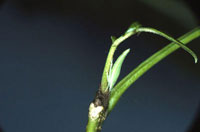Cicadellidae spp.
Hosts
All trees and shrubs
Appearance and Life Cycle

Photo credit: AAFC-Agroforestry Development Centre
Leafhoppers are slender, fragile, boat-shaped insects. Colours vary and they range in length from 3-10 mm. Adult leafhoppers are winged. Both nymphs and adults are equipped with piercing/sucking mouthparts and their hind legs are designed for jumping. Leafhoppers overwinter in the egg stage, with a few species overwintering as adults. The overwintering adults emerge in early spring and begin depositing small, whitish, elongated and slightly curved eggs into slits cut into tender plant tissue. Nymphs hatch and begin feeding on the succulent leaves. Young nymphs resemble adults, except for being smaller and wingless. Nymphs must pass through four or five molts before they become adults. In the fall, adult females deposit their eggs in slits cut into stems and twigs of the host. Leafhoppers complete from one to six generations in a growing season, depending on the species.
Damage

Photo credit: AAFC-Agroforestry Development Centre
Leafhoppers feed by piercing plant tissue with their mouthparts and sucking the juices. Damage varies from curling, wilting, browning or white stippling of the leaves. Slitting plant tissue to deposit eggs also causes injury. Many leafhoppers carry destructive viruses, which may kill the host. Leafhopper feeding on forest and shade trees causes no permanent damage.
Control
Leafhoppers have many natural enemies including green lacewings, ladybird beetles, wasps and many parasites. If natural enemies are ineffective, one of the following insecticides can be used: carbaryl; diazinon; malathion or methoxychlor.